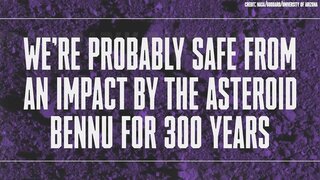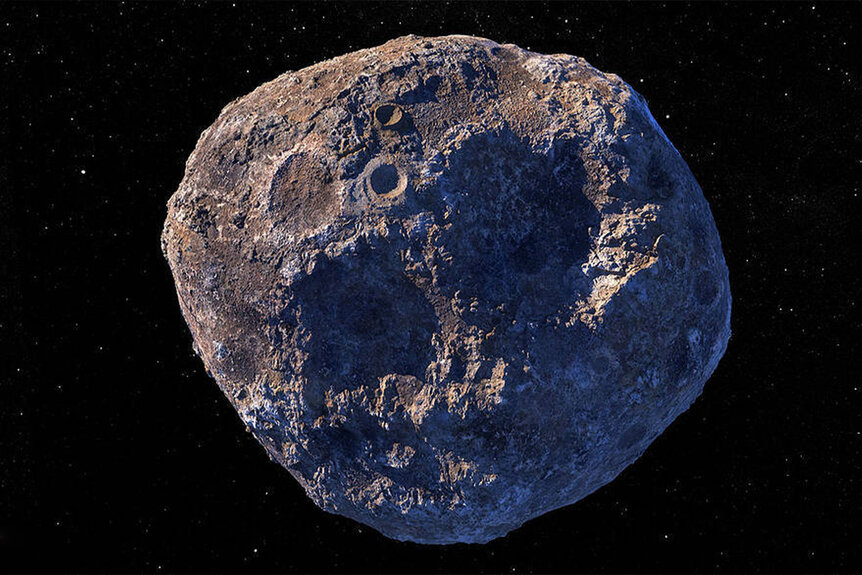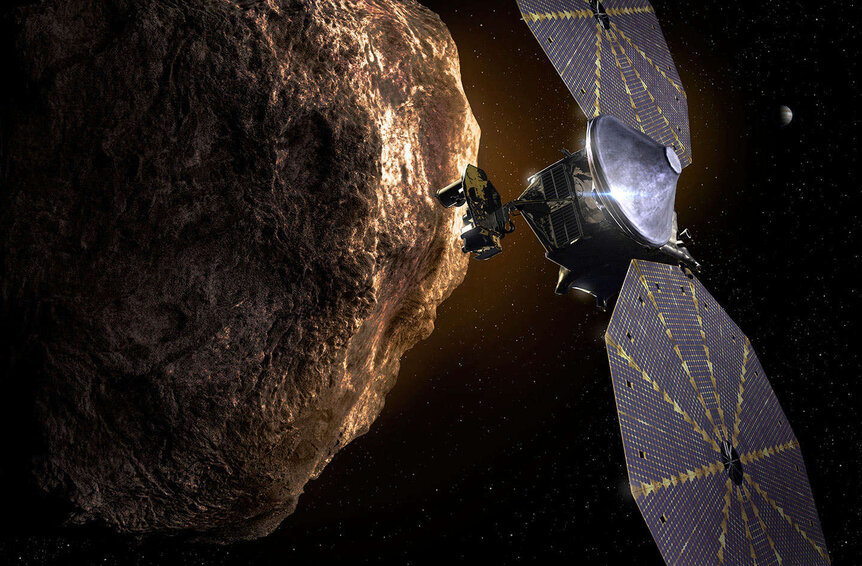Create a free profile to get unlimited access to exclusive videos, sweepstakes, and more!
Everything You Need to Know About NASA's "Asteroid Autumn"
All asteroids, all the time!
In Wes Anderson’s Asteroid City (streaming now on Peacock), a group of students and parents arrive at the titular fictional city for an astronomy convention. During an award’s ceremony near the meteor fragment for which the city derives its name, a tentative-looking space alien arrives and steals the meteor right in front of the gathered crowd. The close encounter sets off a series of events which will redefine the lives of everyone in town.
All of that from one little asteroid chunk in one small town. And here, in the real world, we have an entire “Asteroid Autumn” happening right now. That’s the unofficial name surrounding the next couple of months of NASA’s space exploration activities, much of which is focused around exploring and understanding asteroids in our solar system. If you want a few more asteroids in your life, these are the missions to keep an eye on.
OSIRIS-REx Returns Asteroid Sample to Earth
OSIRIS-REx launched nearly a decade ago in September of 2016. It spent years in space, first traveling to the asteroid Bennu, then orbiting and mapping its surface. After two years spying Bennu from a short distance, the OSIRIS-REx spacecraft slowly descended to the asteroid’s surface and scooped up a sample in a return canister.
RELATED: NASA First Ever Asteroid Sample Return Mission Successfully Lands in Utah
Then it had the long return trip back to Earth with its precious cargo in tow. On September 24, the OSIRIS-REx spacecraft got close enough to Earth to release the return capsule before heading back out into space for the next part of its mission. The capsule went on to enter the atmosphere and land safely at the Department of Defense’s Utah Test and Training Range in Utah’s West Desert.
On Monday, September 25, the sample canister was loaded onto a U.S. Air Force C-17 and transported to Ellington Field, before being moved to its final home at Johnson Space Center in Houston, Texas.
There, scientists have crafted a custom-made clean room and spent months practicing the procedures for opening the canister and investigating its contents. The sample contains an estimated 8.8 ounces or 250 grams of untarnished asteroid material as old as the solar system, offering us a unique window into our own past.
NASA’s Psyche Mission Prepares for Launch
NASA’s Psyche mission plans to tour a planetesimal asteroid called 16 Psyche, potentially giving us a view into the center of our own planet. Planetesimals are the bits leftover from the creation of the solar system. As dust interacts and sticks together in a protoplanetary system, it forms into increasingly larger rocks until those rocks or collections of rocks are massive enough to hold together under the force of their own gravity.
Some of those planetesimals will continue to grow, becoming planets or moons. Others get ejected from the system or else settle into wide orbits in the asteroid belt or out beyond Neptune. The asteroid 16 Psyche is believed to be the leftover core of a failed planet, made almost totally of valuable metals like iron, nickel, and gold. If we could bring it home, it would have an estimated value of $10 quintillion, outstripping the total global economy by 5 orders of magnitude.
RELATED: NASA Prepares for Launch to Golden Asteroid Worth $10 Quintillion
The Psyche spacecraft recently completed fueling and testing on the ground and is now preparing for blast off. At the time of writing, launch is planned for the morning of October 5, from launch pad 39A at Cape Canaveral. After getting into orbit, Psyche will begin its six-year, 3.6 billion kilometer (2.2 billion mile) journey to Psyche, the crown jewel of the solar system.
NASA’s Lucy Spacecraft Approaches Asteroid Dinkinesh
OSIRIS-REx was focused on the asteroid Bennu for close to a decade. Now, having successfully delivered a sample to Earth, it’s turning its sights toward the asteroid Apophis. Psyche will focus on the single asteroid which bears its name. By contrast, the Lucy mission plans to visit at least nine asteroids over the course of the next 12 years.
RELATED: Lucy’s Wild Ride to Jupiter’s Orbit… But Not to Jupiter
Based on the original mission plan, Lucy wouldn’t have had its first close encounter until 2025, but plans have changed and Lucy will have its first brush with an asteroid on November 1. “There are millions of asteroids in the main asteroid belt. I selected 500,000 asteroids with well-defined orbits to see if Lucy might be traveling close enough to get a good look at any of them, even from a distance. This asteroid really stood out. Lucy’s trajectory as originally designed will take it within 40,000 miles of the asteroid, at least three times closer than the next closest asteroid,” said Raphael Marschall, Lucy collaborator of the Nice Observatory in France, in a statement.
The asteroid in question has since been named Dinkinesh and is only about half a mile in diameter. Once it was identified, mission controllers sent instructions for Psyche to make a course adjustment on May 9. The short burn shifted its velocity by about 7.7 miles per hour. Between May and November, that small change shifted Lucy’s position by roughly 40,000 miles, allowing it to pass within 265 miles of Dinkinesh.
DART’s One-Year Anniversary of Punching an Asteroid
Who among us isn’t at least a little bit worried that an asteroid might show up and pull the curtain on humanity? If it’s good enough for the dinosaurs, it’s good enough for us. Fortunately, astronomers who spend a lot of time studying near-Earth objects aren’t all that worried.
We know where most of the big asteroids are, and we’ve calculated their orbits out hundreds of years. We’ve crunched the numbers and we know the probabilities; we’re in the clear for the foreseeable future. But scientists aren’t resting on their laurels. Just in case, they’re busy developing methods of knocking an overzealous asteroid out of the sky.
RELATED: BOOM! DART Changed the Orbit of Asteroid Dimorphos Even More Than We’d Hoped
Short for Double Asteroid Redirection Test, NASA’s DART mission flew 11 million kilometers (6.8 million miles) and smashed into the asteroid Dimorphos at incredible speed. That impact happened a year ago today, on September 26, 2022. The hope was that DART might impact with enough force to shorten the orbit by a little more than a minute. When the dust settled and astronomers took a look, they found that Dimorphos’ orbit had shortened by roughly 32 minutes. The mission served as a successful proof of concept that we could change an asteroid’s trajectory in a measurable way if we needed to.
With enough advanced warning we could move even a very large object out of the way before it hit us. We don’t know about you, but just knowing that helps us sleep a little easier.
If you’re still hungry for asteroids, catch Wes Anderson’s Asteroid City, streaming now on Peacock.


































